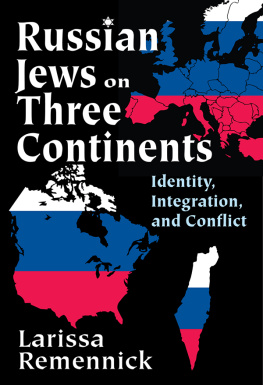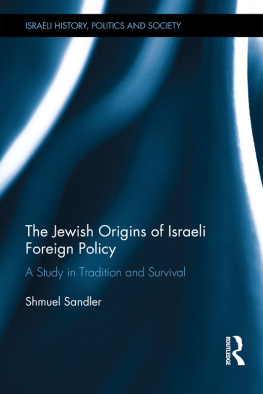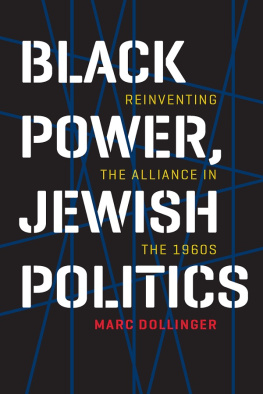First published 2015 by Transaction Publishers
Published 2017 by Routledge
2 Park Square, Milton Park, Abingdon, Oxon OX14 4RN
711 Third Avenue, New York, NY 10017, USA
Routledge is an imprint of the Taylor & Francis Group, an informa business
Copyright 2015 by Taylor & Francis
All rights reserved. No part of this book may be reprinted or reproduced or utilised in any form or by any electronic, mechanical, or other means, now known or hereafter invented, including photocopying and recording, or in any information storage or retrieval system, without permission in writing from the publishers.
Notice:
Product or corporate names may be trademarks or registered trademarks, and are used only for identification and explanation without intent to infringe.
Library of Congress Catalog Number: 2014043968
Library of Congress Cataloging-in-Publication Data
Peretz, Pauline, author.
[Combat pour les Juifs sovitiques. English]
Let my people go: the transnational politics of Soviet Jewish emigration during the cold war/Pauline Peretz; translator, Ethan Rundell.
pages cm
Includes bibliographical references and index.
ISBN 978-1-4128-5675-1
1. Jews--Soviet Union--History. 2. Jews--Soviet Union--Migrations.
3. Refuseniks. 4. United States--Relations--Israel. 5. Israel--Relations-
United States. 6. United States--Relations--Soviet Union. 7. Israel-
Relations--Soviet Union. 8. Soviet Union--Relations--Israel. 9. Soviet
Union--Ethnic relations. I. Title.
DS134.85.P4713 2015
325.247089924009045--dc23
2014043968
ISBN 13: 978-1-4128-5675-1 (hbk)
Translated with the help of the Fondation pour la Mmoire de la
Shoah, Paris.
Introduction
In December 1987, on the eve of the summit that would bring together Ronald Reagan and Mikhail Gorbachev in Washington, DC, a crowd of two hundred thousand people demonstrated on the Mall, demanding that the secretary general of the Communist Party allow Jews to leave the Soviet Union. This mass rally was an expression of the incredible support enjoyed by Soviet Jews in the United States at the end of the Cold War. But of all the victims of the Soviet regime, why did they alone benefit from such help when so many others deserved help too? Because Israel and the American Jewish community initiated an unprecedented mobilization on behalf of Soviet Jews, and the United States government embraced the struggle once becoming convinced that the Jews emigration was a humanitarian issue requiring its intervention.
Immediately after the Soviet Union opened its borders, numerous publications addressed the consequences of the mass arrival of Soviet Jews in the United States and Israel, with the result that scholars have generally neglected the origins of the emigration. Whenever the American mobilization on behalf of Soviet Jews has been the object of historical study, it has been portrayed as an effort to compensate for the communitys inability to assist European Jews during World War II. Published in 1999, A Second Exodus, edited by Murray Friedman and Albert Chernin, is the outcome of this effort to reevaluate past community action. His approach defined a new direction, allowing scholars to break with the logic of a community satisfied with itself and its actions and instead to explain in nonideological fashion the succession of objectives (ranging from gaining respect for cultural and religious rights to winning the right to emigrate) and stages of the mobilization (from the emergence of the Soviet Jewish question in community circles and public opinion to the definition of this question as a humanitarian concern, setting it on the agenda, and finally changing US policy toward the Soviet Union). The perspective needed to be as broad as possible, which meant studying the movement to aid Soviet Jews from its beginnings in the 1950s up to the opening of Soviet borders. The analysis therefore follows a tortuous path, leading from Israel and community circles in the United States, where the question of Soviet Jewish emigration was born; to Congress, where it was reformulated; and then to the White House, where it was appropriated. This is the only way to explain how Soviet Jewish emigration became a foreign policy objective of the United States during the Cold War, initiating a period when human rights became a decisive element in Americas policy toward the Kremlin.
Until the publication of this book in French, the international dimension of the American mobilization in support of Soviet Jews had been largely overlooked. The movement had generally been understood as isolated and unconnected to the activities of other diaspora communities. My research, however, has revealed the activities of an Israeli office named Nativ that, beginning in 1953, secretly sought to secure the immigration of Soviet Jews to Israel. Nativs operation was twopronged, combining direct action among Jews behind the Iron Curtain with a campaign to promote awareness in numerous Western countries, which was most successful in the United States. To study the American movement, therefore, it was absolutely necessary to explore the Jewish states role as a catalyst and subsequent influence.
Until the middle of the 1990s, the activities of Nativ were clandestine, and the silence around the organization was broken only in 1995 with the publication of a memoir by Nativs second director and the appearance of several articles in the Israeli press. Moreover, these publications were subjected to censorship, both by the Israeli Ministry of Foreign Affairs and by Nativ itself. They thus remained silent in regard to the most sensitive issues.
My aim has been to reintroduce Israel as the missing yet absolutely decisive actor in the history of the American movement. Instead of attempting to exhaustively describe the operations organized by Nativ (something that would have been extremely difficult, in any case, for lack of sources), I have sought to answer a number of questions: How did the cause of Soviet Jews, originally an Israeli concern, become an American one? How did the Soviet Jewish emigration, initially a Zionist objective, come to be defined as the aim of an American movement for the defense of human rights in the Soviet Union? Understanding the role Israel played in setting the agenda for a segment of the American Jewish community requires a careful examination of the relations between the Jewish state and its diaspora: To what degree did Israel exercise influence over the American Jewish community, and on the basis of what model should these relationships be conceptualized? What made this influence possible? Finally, did it represent a threat to American democracy? This last question is unavoidable, given that the American movement led to a major change in foreign policy.
The US Congresss adoption of the Jackson-Vanik Amendment in 1974 was the movements most visible and lasting consequence. This amendment, which conditioned the extension of economic advantages to the Soviet Union on its respect for the right of minorities to emigrate, was the first time that the emigration of Jews had been placed on the agenda between Washington and Moscow. The context of its adoption has until now been studied only by Paula Stern, Israel, but rather to the Soviet Union, a superpower that was, during the Cold War, the second-largest home to the Jewish diaspora.
This study participates in an old debate concerning the role of special interest groups (and, more particularly, of ethnic interest groups) in US foreign policy. Special interest groups are an essential component of American political life, and indeed the Bill of Rights recognizes the right of the people peaceably to assemble, and to petition the Government for a redress of grievances. Since the United States was founded on the separation of powers and institutional pluralism, the American political system allows organized groups to weigh in on the course of policy, and foreign policy in particular. It is thus considered normal that ethnic groups closely follow affairs in their homelands and attempt to influence foreign policy in a direction favorable to them. This influence grew significantly at the end of the 1960s, thanks to the expanding role of Congress and the new legitimacy acquired by ethnic groups.









